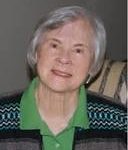Throughout Ruth Kirk’s long career as a writer and naturalist, she has been what she calls a “paper ranger.”
She has climbed mountains, scoped trails, observed the flora and fauna, and then written about all those experiences. Her 37 books and 12 films and videos range from Death Valley to the Hoh Rain Forest—a lifetime spent paying attention to human history and natural history and interpreting it for readers. “I really think books are good,” she says. “We all can enjoy our dance through this life more if we know about the stage that we’re dancing on.”
She began as a “park service in-law—a wife!” she jokes, serving with her husband Louis Kirk in various national parks. Their first assignment was Death Valley, where she had often camped with her family while growing up in Los Angeles. She remembers counting falling stars as she and her sister and brother went to sleep. Her interpretive writing career began there in 1954. Ansel Adams provided photographs for a book on Death Valley; art critic Nancy Newhall wrote the text, and Kirk wrote the guide section. Two years later, she and Louis authored Exploring Death Valley, the first in a series of five exploring books which included Yellowstone, Crater Lake, Mount Rainier, and Olympic National Parks.
From the open spaces of the desert, the Kirks moved to the more closed spaces of the rain forests and to the glaciers of Mount Rainier in the 1960s. While Louis served as a ranger-naturalist, she wrote interpretive material and hiked the wilderness beaches, the South Hoh Valley, and the trail up the Queets, reached only by wading across the river, a challenge she enjoyed but treated respectfully when rains were likely to raise the river. Many times she hiked from Lake Ozette to Cape Alava—in the early years, over a trail so muddy it pulled a heavy leather boot off her foot. In 1974 she co-authored a book on the Ozette archeologist Richard Daugherty of Washington State University, one of several collaborations in her long writing career.
As she raised two sons, Kirk wrote before dawn and in the evenings when the children were asleep, even taking manuscripts to the bathtub, keeping them dry by propping them up on her knees.
Together the Kirks built the Spruce Nature Trail up the Hoh Valley, now one of the most popular trails in the park. They laid it out with the goal of providing an optimal sample of the forest to see and better understand the whole ecosystem. The trail includes a colonnade of huge trees, with roots straddling the nurse logs they sprouted on centuries ago. Through this trail and much of her writing, she wanted people to be very much aware that “we are just one critter on one strand of the great intricate web.”
At Olympic National Park she climbed Mount Olympus, and at Rainier, she climbed the mountain five times, once with two rangers carrying a sack of cement to put a new benchmark on the summit. Usually on trail she carried no more than 35 pounds on a Trapper Nelson wooden frame, but none of that weight was ever water. On the Wonderland Trail, she said, “We carried empty cuts, our Rainier canteens we called them, and drank from them at each stream we crossed.” A favorite trail was to the old Ice Caves at Paradise. “They were beautiful; you could walk in them for perhaps a quarter mile.” The caves were closed in 1971, and the ceiling had collapsed by 1991.
Two concepts permeate her writing: an awareness of the whole, that reality is not fragmented, and also an awareness of time, that human life, even as a species, is less than a snap of the fingers. By paying attention to place, recording and interpreting it, she makes readers aware of what we have and of what we are losing.
Some of Ruth’s best known books are Exploring Washington’s Past, an ambitious and comprehensive auto tour of every site of historic note in the state; Archaeology in Washington; and her illustrated history of Mt. Rainier, Sunrise to Paradise: The Story of Mount Rainier National Park. Her last book before she “put the pencil down” was Ozette: Excavating a Makah Whaling Village. Ruth received the Guild award in 1996. She lives in Lacey, Washington.